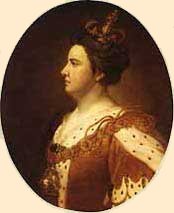 Anne
AnneHouse of Stuart -- Reigned: 1702-1714 1665-1714
She married George, Prince of Denmark, but the pair failed to produce a surviving heir. She died at 49 years of age, after a lifelong battle with the blood disease porphyria. The untimely death of William III nullified, in effect, the Settlement Act of 1701: Anne was James' daughter through his Protestant marriage, and therefore, presented no conflict with the act. Anne refrained from politically antagonizing Parliament, but was compelled to attend most Cabinet meetings to keep her half-brother, James the Old Pretender, under heel. Anne was the last sovereign to veto an act of Parliament, as well as the final Stuart monarch. The most significant constitutional act in her reign was the Act of Union in 1707, which created Great Britain by finally fully uniting England and Scotland (Ireland joined the Union in 1801). The Stuart trait of relying on favorites was as pronounced in Anne's reign as it had been in James I's reign. Anne's closest confidant was Sarah Churchill, who exerted great influence over the Queen. Sarah's husband was the Duke of Marlborough, who masterly led the English to several victories in the War of Spanish Succession. Anne and Sarah were virtually inseparable: no king's mistress had ever wielded the power granted to the duchess, but Sarah became too confident in her position. She developed an overbearing demeanor towards Anne, and berated the Queen in public. In the meantime, Tory leaders had planted one Abigail Hill in the royal household to capture Anne's need for sympathy and affection. As Anne increasingly turned to Abigail, the question of succession rose again, pitting the Queen and the Marlborough against each other in a heated debate. The relationship of Anne and the Churchill's fell asunder. Marlborough, despite his war record, was dismissed from public service and Sarah was shunned in favor of Abigail. Many of the internal conflicts in English society were simply the birth pains of the two-party system of government. The Whig and Tory Parties, fully enfranchised by the last years of Anne's reign, fought for control of Parliament and influence over the Queen. Anne was torn personally as well as politically by the succession question: her Stuart upbringing compelled her to choose as heir her half-brother, the Old Pretender and favorite of the Tories, but she had already elected to side with Whigs when supporting Mary and William over James II. In the end, Anne abided by the Act of Settlement, and the Whigs paved the way for the succession of their candidate, George of Hanover. Anne's reign may be considered successful, but somewhat lackluster in comparison to the rest of the Stuart line. 1066 and All That, the British satire, describes her with its usual tongue-in-cheek manner:
|
All rights reserved. For details and contact information: See License Agreement, Copyright Notice. |
 Anne, born in 1665, was the second daughter of
Anne, born in 1665, was the second daughter of